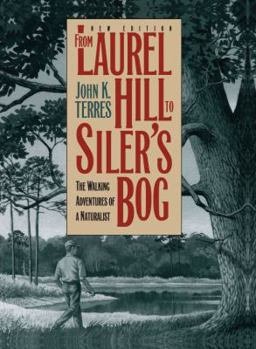From Laurel Hill to Siler's Bog: The Walking Adventures of a Naturalist
(Part of the Chapel Hill Books Series)
Select Format
Select Condition 
Book Overview
From Laurel Hill to Siler's Bog presents the fruits of a scientific as well as affectionate association between a dedicated naturalist and the birds, mammals, and insects of a small, wild world. John... This description may be from another edition of this product.
Format:Paperback
Language:English
ISBN:0807844268
ISBN13:9780807844267
Release Date:October 1993
Publisher:University of North Carolina Press
Length:256 Pages
Weight:0.80 lbs.
Dimensions:0.7" x 6.0" x 8.0"
Customer Reviews
2 ratings
Revisiting a memorable story
Published by Thriftbooks.com User , 21 years ago
After I read this book the first time, I donated it to a local nature center library. But a part of it stayed with me, and I found myself thinking about it and occasionally sharing it with others. So when I saw another copy of this volume in a used bookstore, I scooped it up for myself. I stood there and thumbed through the pages until I found it -- Chapter 10, "Flying Squirrels: Phantoms of the Night," the story of a young flying squirrel named Hepsey. John Terres had the opportunity to keep Hepsey almost like a pet for most of her life. While that kind of arrangement is generally not a good one for human or for wild creature (and would easily have been fodder for a 1960s Disney film), Terres learned quite a bit about squirrels that a more formal study might not have revealed. He wondered about her nut-hiding talent, for example. So he put 100 hickory nuts out on a table and left the house. When he came back, each nut was hidden somewhere -- in a shirt pocket, in a shoe, etc. He put another 100 nuts out that same night, and they disappeared as well. Based on Hepsey's behavior, Terres projected that a typical squirrel could probably store 10,000-12,000 nuts in one winter season. A fascinating tidbit of information like that sticks in your head. But the fun of it all is in his narration of the escapade and of other Hepsey happenings. That chapter is arresting enough to warrant reading aloud during a nature center program.Terres' ruminations and nature observations are based on his rambles through the North Carolina landscape. "How Vultures Find Their Prey" is another interesting test (by sight or by smell?) that you will remember. But it's Hepsey who will capture your imagination.
interesting wanderings
Published by Thriftbooks.com User , 23 years ago
Terres, who was editor-in-chief at Audubon, spent a decade wandering the Mason Farm Biological Reserve in Chapel Hill, NC. The former farm was donated to the University of North Carolina to allow students to observe the wildlife there. Terres, likewise, set out to chronicle the life he found there, hiding in blinds, perching in tree stands, etc.. & he offers a wonderful account of his observations. He describes each of the seasons & then gives detailed descriptions of the lives and habits of some of the farms residents: flying squirrels, turkey vultures, wild turkeys, cottontail rabbits, and the like. He came to know some of these creatures individually, including a heroic black turkey and his own pet flying squirrel. He endows them with personality and character and, like him, we start rooting for them in their struggles to survive. GRADE: B+





